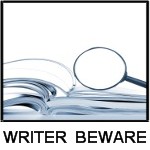Wholesale vs. Agency: Sales Models in Conflict
 Posted by Victoria Strauss for Writer Beware
Posted by Victoria Strauss for Writer Beware
One of the big publishing headlines this month(here, for instance) was that e-books from some popular authors were selling on Amazon for higher prices than the hardcover versions. For instance, the hardcover of Ken Follet’s Fall of Giants was priced at $19.39, while the digital version cost $19.99. James Patterson’s and Howard Roughan’s Don’t Blink was going for $14.00 in hardcover, and $14.99 in digital.
Predictably, Kindle-maniacs flipped out, slamming the books with one-star reviews and angry comments. “The publisher expects more for the Kindle electronic version than the hardback. It is unfortunate the publishing industry continues to live in the past…Take advantage of your customers and feel their wrath,” wrote one commenter. “It is ridiculous that the publisher is charging more for the Kindle version than the hardcover,” wrote another. “The price for this eBook is outrageous (more than the hardcover edition!) Send a message to the publisher that we consumers will not be bilked out of our money to satisfy their greed,” wrote a third.
I won’t argue that $19.99 or even $14.99 is too much to pay for an e-book–especially since, if you use an e-book reader such as the Kindle, you are buying a license, not a book. And I do believe that consumer pressure will ultimately force prices down (though many consumers who demand low-priced e-books don’t seem to grasp that publishers have fixed costs that must be recouped across all versions of a book, even the versions that are cheaper to produce). But it’s wrong to punish authors by giving one-star reviews, or claiming that publishers and authors are in cahoots. Authors have no control over the prices at which their books are sold.
In this particular case, it’s also wrong to blame publishers, since the pricing discrepancies that have stirred up so much bad feeling are Amazon’s doing. What we have here isn’t nefarious price-fixing by greedy, backward-looking publishers determined to cripple e-book adoption, but a conflict between two fundamentally different models of book selling.
Under the wholesale model that has defined book selling until very recently, publishers set the list price of books and sell them to retailers at a substantial discount. The retailers then sell the books to consumers at whatever prices they choose, and keep the profit–or swallow the loss. Retailers like Amazon often sell popular books at deep discount, accepting a loss as a way to bring in customers. For instance, Fall of Giants, which at nearly 1,000 pages is a true doorstopper, has a list price of $36.00, but Amazon is selling it for just $19.39. Don’t Blink has a list price of $27.99, but on Amazon it costs $14.00.
By contrast, under the recently-introduced agency model that has come to dominate the selling of e-books, retailers become “agents” through which publishers sell books directly to consumers. The agency model doesn’t allow for discounting; retailers simply pass books to consumers at the price set by publishers, and receive a commission on sales.
So Amazon can do whatever it wants with print prices–but for e-books, it is locked into the publisher’s price. The occasional result: hardcovers that cost less to buy than e-books, even though the list prices for the hardcovers are considerably higher than the list prices for the e-books (a point apparently completely missed by the Follett and Patterson one-star brigade).
In other words, there is a mismatch between Amazon the retailer and Amazon the agent. While I’m sure that the current surge of customer outrage doesn’t make Amazon too unhappy, given that it doesn’t like the agency model and has been actively encouraging its customers to target publishers by slapping scarlet letters on agency model e-books in the form of disclaimers (“This price was set by the publisher”), the competition between these different book selling models does no one any good. It benefits neither publishers nor retailers to have sales policies that conflict. This is something that will urgently need to be worked out in the future.
(And by the way, for Kindle owners who wax nostalgic for the $9.99 ebooks of yore: that low price point was selectively applied. Ebooks from popular authors sold for $9.99, but ebooks from midlist and obscure authors sold for list price, which was often quite a bit higher.)


